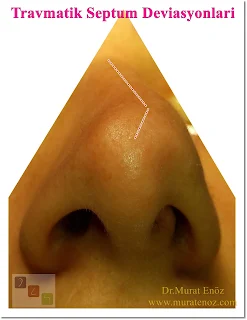Genetic and Traumatic Factors Can Cause The Deviated Nasal Septum
It is mentioned that there is a “nasal septum deviation anlam which means that if the wall between the nasal passages (nasal septum) is bent to one side, it is a distorted or bent septum. Many people have more or less this curvature in the nasal septum. When the deviation of the nasal septum is advanced, it may block one side of your nose and reduce airflow and may have difficulty breathing. Nasal obstruction may result from the curved nasal septum, swelling of the “nasal flesh indeki in the nasal cavity or both. The treatment of nasal congestion may include medications for reducing swelling or nasal expanders that help open the nasal passages. For the treatment of nasal cartilage curvature, i deviation surgery olan is required.
Deviation of the nasal septum can occur mainly for two reasons:
• A condition that arises at birth. In some cases, deviation of the septum may occur during fetus development and is evident at birth (curvature of the nasal septum may occur due to the effect of genetic inheritance).
• Nose injury. Nasal cartilage curvature may result from damage that may cause it to be removed or bent from its position in the nasal chamber. In infants, this type of injury can occur during childbirth. Nasal bone curvature may occur in children and adults due to many different nasal injuries and deviations of the septum. Nasal trauma most often occurs during fighting, contact sports, active physical play or automobile accidents.
Nasal Septum Deviation is present in 60-80% of people!
Deviation of the nasal septum is seen in approximately 60-80% of the population. In other words, cartilage curvature may be present without symptoms such as nasal congestion, difficulty climbing stairs, deterioration in sleep quality, mouth open sleep. In all patients with nasal spetum deviation, surgery is not necessary unless there are signs of nasal cartilage curvature.Traumatic Nasal Septum Deviation
Nasal cartilage curvatures after nasal trauma may be more severe than congenital cartilage curvatures and may present with nose-like curvatures or defromites. The effects of nasal trauma, especially in childhood, can occur as the nose continues to grow and very different nasal deformities (curved nasal deformity, C nasal deformity ...) can occur. Trauma to the tip of the nose may result in curvatures (caudal septum deviation) or septal dislocation (anterior septal dislocation) in the caudal septum, the lowest part of the nasal septum. In the photograph, the asymmetrical appearance of both the nasal bone and the tip of the nose after the fall on the nose in childhood and the protrusion due to the deviation of the cadaveric septum appear to be inside the left nostril.Deviation of the nasal septum can be exacerbated by recurrent nasal trauma!
Structural changes such as fracture, bending, and thickening of the nasal septum may occur, especially in those interested in close combat sports and in people who suffer from recurrent facial trauma due to mental retardation or neurological disease. Many punters can make the nose tip softer by pressing the palm of a hand and nose tip from front to back and rolling. In this way, the lower and anterior parts of the nasal septum are crushed and softened repeatedly. Sometimes, septic cartilage may develop after septic hemorrhage (septal hematoma) into an abscess or infection.
Murat Enoz, MD, Otorhinolaryngology, Head and Neck Surgeon - ENT Doctor in Istanbul
Private Office:
Address: İncirli Cad. No:41, Kat:4 (Dilek Patisserie Building), Postal code: 34147, Bakırköy - İstanbul
Appointment Phone: +90 212 561 00 52
Appointment Phone: +90 212 561 00 52
Fax: +90 212 542 74 47



.jpg)
Comments
Post a Comment